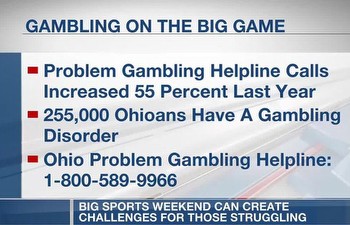Survey: Gambling Overall And Problems Both On The Rise In Ohio

Even before legal sports betting became available to them this year, Ohioans were gambling a lot more in general and exhibiting a lot more potential problems from it, according to a comprehensive state survey.
Over a five-year span between 2017 and 2022, the share of Ohio’s population that gambles went up from about three of every four to more than four out of five. The percentage estimated to be problem gamblers increased from 0.9% to 2.8%, and the latest survey pegged an additional 17% as potential problem gamblers at low or moderate risk.
Those were key conclusions from interviews conducted by Ohio State University’s Center for Human Resource Research with more than 14,000 Ohio adults in the second half of 2022. The state set a mandate to conduct such a survey every five years as a result of the initial legalization of casinos. The state has four of those, plus seven racinos and the lottery. Since Jan. 1 it has had legalized retail and mobile sports betting, but no online casino gambling — at least none that is legal.
While a comprehensive report on the latest findings is still being prepared, key highlights were presented last week to members of the Ohio Casino Control Commission, which collaborates on the every-five-year study with the Ohio Department of Mental Health and Addiction Services, Ohio Lottery Commission, and Ohio State Racing Commission.
Among the findings were that young adults, Blacks, Hispanics, and particularly those who gamble online were at highest risk of having problems. The assessment was made through how respondents answered nine standard questions used in a problem gambling screening index, such as whether they had bet more than they could afford, chased losses, borrowed money, or suffered consequential health problems such as stress and anxiety.
Nearly 83% of Ohioans 18 and older who were surveyed reported risking money on casino games, sports, online gambling, the lottery, or other forms of gambling in the prior year. That was up from about 75% in 2017 and 59% in 2012.
The table below compares the percentage of surveyed Ohioans who reported gambling in 2012, 2017, and 2022, and the percentage of those who were deemed to be problem gamblers or at low or moderate risk for it.
Pandemic and normalization cited as factors
Amanda Blackford, the casino commission’s director of operations and problem gambling services, said the tripling of the percentage of adults in the highest-risk category poses the most concern. The 2.8% estimate equates to nearly 255,000 Ohio adults.
While she said there’s no clear-cut explanation for the increase, she noted in an interview with US Bets that the surveying — which asked respondents about their behavior in the prior 12 months — covered a period when society was still coming out of the height of the COVID pandemic.
There was more likelihood at that time “of seeing comorbid disorders with problem gambling, such as elevated rates of depression, anxiety, and other substance use,” Blackford said.
At the same time, she said that even though legal sports betting was not available at the time of the survey, the fact that lawmakers had already acted to legalize it had given attention to wagering as something more people might feel OK to indulge in by some means. In general, society has become more accepting of various forms of legalized gambling over the past decade, which might also have made more people willing to acknowledge problems from it.
“We knew that with any expansion comes increased risk,” Blackford said. “We were prepared for the numbers to be higher than they were in 2017, just given all the talk of legalization. … With any form of newly legalized gambling, you have to be ready to serve more people.”
While Ohio has not legalized online casinos, Blackford noted that the biggest risks were found among respondents who engaged in some form of online gambling in the prior year. Among them, just 49% scored as non-problem gamblers, while 10.4% answered questions in a manner identifying them as problem gamblers and another 40.6% fell into the low-to-moderate risk categories.
Blackford said that was consistent with findings of higher-than-average rates of problem gambling in a recent Rutgers University study of adults in New Jersey, where online casinos have been legal for a decade.
“Being able to do online gambling in isolation and do it so constantly and consistently, it certainly plays into those factors where we see individuals have an elevated risk,” she said. “Individuals in the disordered category are more likely to be gambling at odd hours of the day and spend more time doing so. … Gambling is already called the hidden addiction, and some of those factors address those kinds of behaviors.”
Without awaiting the latest survey findings, state officials in Ohio have undertaken a number of new initiatives aimed at problem gambling prevention and treatment through an inter-agency collaboration known as Ohio for Responsible Gambling.
The Time Out Ohio program was an online expansion of the voluntary self-exclusion list that was formerly available to people wanting to keep themselves out of casinos if they showed up in person to register. Since last December, 955 people have signed up online to protect themselves from excessive gambling of various kinds, including access to online sports betting now.
The state also subsidizes individuals enrolling in the Gamban program, by which their phones and computers have blocking software added to prevent them from accessing gambling sites.
And Blackford noted that a new form of help is available from the state for individuals who need gambling addiction counseling but who live in an area where it is hard to find and access certified specialists. Those calling the state’s problem gambling helpline (800-589-9966) can be transferred in timely fashion to a clinician providing telehealth services, with costs covered by a state grant to the Problem Gambling Network of Ohio.
In one other new wrinkle in Ohio lauded by responsible gambling advocates, the University of Cincinnati’s School of Social Work has developed an addition to its curriculum through which students can take specialized studies in problem gambling, which is not normally offered at universities.


































